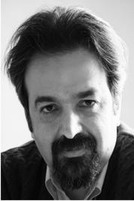
UnTwelve is proud to present an interview with our 3rd prize winner from the 2011 composition competition, Shaahin Mohajeri. His entry, titled Three Micromusics for an Ant, was written for "santoor duet" in 12 out of 96 EDO.
Shaahin Mohajeri, born 26 July 1971 in Tehran, Iran, is a tombak player, tombak researcher and microtonal composer. He has a B.A in Geology from Tehran University. He composes music for solo tombak and tombak group with different pitches, ranging from traditional to his personal style. He is working on a new musical notation system for tombak as a result of acoustical parameters and a system of fingering classification for this drum. As a microtonalist, he works on different tuning systems such as: equal divisions of length (EDL); arithmetic irrational divisions of (non)octave (AIDO); arithmetic rational divisions of (non)octave (ARDO); equal divisions of octave (EDO); and arithmetic divisions of length (ADL). Shaahin mohajeri believes that 96-EDO is a good system for intervallic structure of Persian music with more accurate estimation than Ali Naqi Vaziri's 24-EDO system. Now, ne is working on a microtonal notation system based on 96-EDO for Persian music and on a model for tuning systems classification based on divisions of octavic or non-octavic musical scales and systems.
UnTwelve: Can you describe your journey to becoming a microtonal composer?
Shaahin Mohajeri: My connection with the world of music started with tombak. I began studying tombak under the supervision of Nasser Farhangfar, master of tombak, but my self-study of the tombak's sound, fingering, and musical analysis and my arrhythmic musical ideas led me to find myself in the musical world. I remember that I tried to have less or more than 12 divisions of an octave. I calculated the frequency and "cents" of these degrees.
While analyzing the tombak's sound acoustically, I learned how to use composing software. I must tell you that I compose experimentally according to my innate musical sense. I studied texts related to the science of composing and learned according to my needs. My first microtonal pieces were in 24-EDO--I tried to retune semitones to have quartertones in my midi files using Cakewalk's pitch wheel. On July 6, 2004, I signed up to the Yahoo tuning group, and I remember that it was the start of my serious experiments in microtonal composing. You must note that as an Iranian traditional music listener I was acquinted with microtones in our radif music and with Ali-Naqi Vaziri's theory of 24 quartertones.
Un12: In my experience, there are more composers who have brief excursions into microtonality than those who make a lasting commitment to it. What aspects of microtonality have sustained your interest, kept you returning to it?
SM: I found that microtonal music is part of my life. A strange and wonderful world of new intervals and musics moved me to think microtonally. These new melodies, harmonies and new musical language is a gift from god to me. I try to test different intervalic models in 96-EDO to find their musical characters.
Un12: In your piece, "Three Micromusics for an Ant", I think I'm hearing three distinct modes or tonalities being used. Can you describe these and how they relate to each other?
SM: I designed a symmetrical scale for this piece, which you can see in this graphic. From that scale I chose 3 different keys (which haven’t any name) to compose.
((image goes here))
The start of my composing process was in choosing keys. The first movement is composed in a key which has degrees like the arrangement of C-major's degrees…the next in another which has degrees in arrangement like the degrees of Bb-Major, and the third with degrees like the arrangement of A-major's. But the most important thing is that I am not bound to use that solid rule. Although these modes have a tonic, I wrote melodic phrases in different tonalities and modes (and maybe sometimes polytonal and polymodal). All of these processes are done only through my sensing of the music, which tells me what to do next…something like written-improvisation. The concept of modes and naming them in microtonality is very interesting for me, and I'm working on it these days.
Un12: This piece also uses what we might call "microrhythms". For you, how is rhythmic understanding related to a microtonal understanding? In what ways are they different?
SM: I think we can relate microtonality to rhythm. I'm working on a model of time intervals based on the theory of tuning systems, which I call "Microrhythm". But as I'm a percussionist the rhythmic complexity for me has a great degree of importance. I have many ideas to use, but because the notation software does not allow me to define my own rhythmic intervals, I cannot compose in my microrhythmical model.
Un12: Have advances in microtonal software instruments changed your attitudes toward live performance? For example, did you write this piece imagining the possibility of a live performance, or is that "beside the point"?
SM: Yes and No…!!! …I enjoy composing with complex structure of rhythm…and different scales in 96-EDO. Due to these complexities and because of a lack of players knowing about microtonality, it is impossible to have a live performance in Iran. I think there is no problem outside of iran; in AFMM's Microfest in 2011, a piece of mine "Barana" was performed for wind sextet. I think it is much better for me to use these software advances in a way to coincide with my musical language and mind instead of live performance. I can hear what I'm doing and can go wherever I want!!